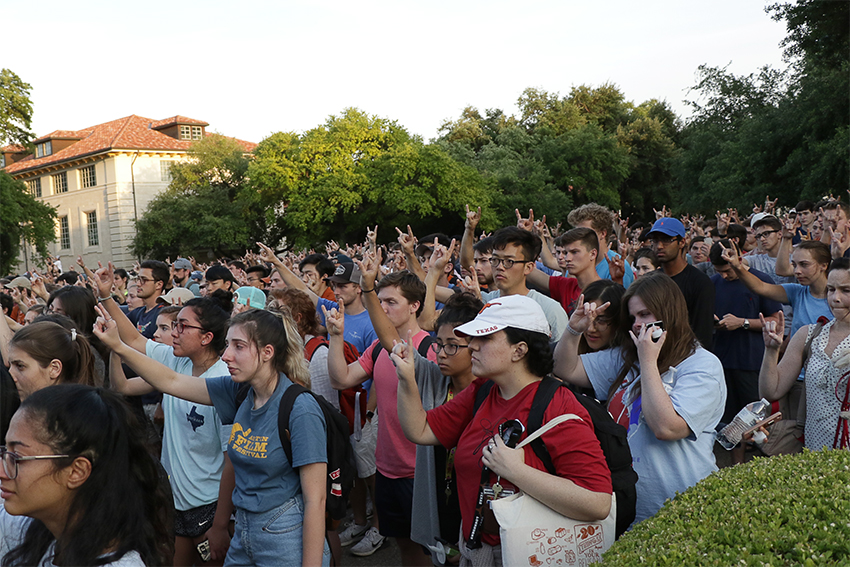Editor’s note: In recent years, the University of Texas at Austin and the The University of Maryland have experienced similar traumas related to campus climate. In recognition that our individual experiences are part of a national conversation, The Daily Texan and The Diamondback exchanged editorials on the subject. The Diamondback’s editorial is viewable here. In“We Asked," the editorial board interviewed students and staff about campus climate.
On May 20, University of Maryland student Sean Urbanski fatally stabbed Richard Collins III as he waited for an Uber. Collins, a Bowie State University student just days from graduation, lost his life visiting a neighboring school in what is now being investigated as a hate crime.
The fear and frustration expressed in Maryland’s student interviews, University statements, and student organizations mirrored our own fears and history of a deteriorating campus climate. Collins — and Urbanski— could have easily been UT students.
It is critical that we recognize our respective universities’ recent violence in the national context of hateful and violent incidents. Our actions, or inaction, in response to recent campus incidences could mean life or death for students who fear that hateful words might turn to violence, as they did at the University of Maryland.
Racist attacks on campuses are on the rise. The Southern Poverty Law Center reported more than 150 incidences of white nationalist flyers since November, part of a generalized increase in fear and anxiety among students post-election. Our campuses experienced this first hand when flyers targeting Chinese, black, and Muslim students appeared at UT, with Islamophobic flyers from the same white nationalist group appearing at UMD.
However, UT’s problems existed long before the election. In 2013, “bleach bombs” thrown at black students garnered international attention, as did The Young Conservatives of Texas’ “Catch an Illegal Immigrant Day.” Last year, three white men hurled glass bottles and racial epithets at a black student, resulting in a still unresolved hate and bias investigation. Muslim students have been spat on, threatened and harassed on the street. Texas Hillel, the campus’ center for Jewish life, had a window broken in a possible act of intimidation. At some point students stop being surprised, and started to wonder — who’s next?
Minority students have long been vocal about their experiences and fears, but it wasn’t until UT lost a student in a deadly stabbing that some saw the true extent of our campus’ deterioration.
On May 1, a student with a history of mental illness walked onto a busy campus plaza and stabbed four students with a Bowie knife, killing freshman Harrison Brown. In the absence of official information following the attack, students turned to Twitter and group messages, where misinformation and rumors abounded. Perhaps due to prior threats made against students involved in Greek life, rumors of assailants holding students at knifepoint to search for Greek letters on their clothing spread fear throughout the UT community. Our phones also lit up with unconfirmed reports of a coordinated second stabbing in West Campus and of a bomb threat at the communications building.
None of this was true. By May 2, police had identified the stabbings as a random act likely caused by compromised mental health. Greek students hadn’t been deliberately targeted, there was no gun, and the reports of the second stabbing and bomb threat were dismissed. In the first critical hours, students assumed that persistent campus climate problems had reached a deadly climax.
Campuses like UT and UMD need solutions, because these issues show no signs of ceasing. If there was any question whether Brown’s death was the end of campus climate concerns, one need only see flyers posted the day after the tragedy baselessly demonized black men. Students need real solutions, and we need them now.
First and foremost, our administrations must improve emergency communications. In times of crisis, administration should be a rock amidst the chaos, offering relevant information in a timely manner. Instead, the informational voids in the aftermath of the UT and UMD stabbings left students in the dark. First reports are never 100 percent accurate, but leaving the spread of information to the rumor mill is much, much worse.
Words matter, and university presidents Gregory Fenves and Wallace Loh must use stronger language to support minority students and students of color. Both presidents appeared tone-deaf to the deeply held fears of their most vulnerable students. Flyers were a driving force behind UT President Fenves calling an emotional town hall on campus climate, where he was criticized for his weak language in official statements about the flyers.
Rebuilding trust also requires transparency in the investigation of hate and bias incidents. Students should be able to track cases’ progress, and see if and when a disciplinary action has been taken. Even expedient and well-run disciplinary investigations accomplish little for campus climate if students do not have a clear understanding of their campus’ decision-making processes.
Many students we spoke to expressed that even with the awareness of discrimination within of UT, students of the Longhorn community have remained largely supportive. Frustration with administration and non-university affiliated hostility is more easily weathered if the student body is united. Considering that Urbanski and many of UT’s hate and bias incidents were students attacking their classmates, our campuses must ask hard questions and decide not what kinds of language is legally permissible — that is a low bar— but what sentiments and attitudes we choose to encourage privately in our conversations, classes, and organizations.
Hatred and murder is a shared experience between our campuses, one we never would have wished for. But now, UMD and UT owe it to ourselves to learn from one another and commit to our students like never before.















